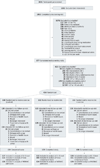Effects of intensive diet and exercise on knee joint loads, inflammation, and clinical outcomes among overweight and obese adults with knee osteoarthritis: the IDEA randomized clinical trial
- PMID: 24065013
- PMCID: PMC4450354
- DOI: 10.1001/jama.2013.277669
Effects of intensive diet and exercise on knee joint loads, inflammation, and clinical outcomes among overweight and obese adults with knee osteoarthritis: the IDEA randomized clinical trial
Abstract
Importance: Knee osteoarthritis (OA), a common cause of chronic pain and disability, has biomechanical and inflammatory origins and is exacerbated by obesity.
Objective: To determine whether a ≥10% reduction in body weight induced by diet, with or without exercise, would improve mechanistic and clinical outcomes more than exercise alone.
Design, setting, and participants: Single-blind, 18-month, randomized clinical trial at Wake Forest University between July 2006 and April 2011. The diet and exercise interventions were center-based with options for the exercise groups to transition to a home-based program. Participants were 454 overweight and obese older community-dwelling adults (age ≥55 years with body mass index of 27-41) with pain and radiographic knee OA.
Interventions: Intensive diet-induced weight loss plus exercise, intensive diet-induced weight loss, or exercise.
Main outcomes and measures: Mechanistic primary outcomes: knee joint compressive force and plasma IL-6 levels; secondary clinical outcomes: self-reported pain (range, 0-20), function (range, 0-68), mobility, and health-related quality of life (range, 0-100).
Results: Three hundred ninety-nine participants (88%) completed the study. Mean weight loss for diet + exercise participants was 10.6 kg (11.4%); for the diet group, 8.9 kg (9.5%); and for the exercise group, 1.8 kg (2.0%). After 18 months, knee compressive forces were lower in diet participants (mean, 2487 N; 95% CI, 2393 to 2581) compared with exercise participants (2687 N; 95% CI, 2590 to 2784, pairwise difference [Δ](exercise vs diet )= 200 N; 95% CI, 55 to 345; P = .007). Concentrations of IL-6 were lower in diet + exercise (2.7 pg/mL; 95% CI, 2.5 to 3.0) and diet participants (2.7 pg/mL; 95% CI, 2.4 to 3.0) compared with exercise participants (3.1 pg/mL; 95% CI, 2.9 to 3.4; Δ(exercise vs diet + exercise) = 0.39 pg/mL; 95% CI, -0.03 to 0.81; P = .007; Δ(exercise vs diet )= 0.43 pg/mL; 95% CI, 0.01 to 0.85, P = .006). The diet + exercise group had less pain (3.6; 95% CI, 3.2 to 4.1) and better function (14.1; 95% CI, 12.6 to 15.6) than both the diet group (4.8; 95% CI, 4.3 to 5.2) and exercise group (4.7; 95% CI, 4.2 to 5.1, Δ(exercise vs diet + exercise) = 1.02; 95% CI, 0.33 to 1.71; P(pain) = .004; 18.4; 95% CI, 16.9 to 19.9; Δ(exercise vs diet + exercise), 4.29; 95% CI, 2.07 to 6.50; P(function )< .001). The diet + exercise group (44.7; 95% CI, 43.4 to 46.0) also had better physical health-related quality of life scores than the exercise group (41.9; 95% CI, 40.5 to 43.2; Δ(exercise vs diet + exercise) = -2.81; 95% CI, -4.76 to -0.86; P = .005).
Conclusions and relevance: Among overweight and obese adults with knee OA, after 18 months, participants in the diet + exercise and diet groups had more weight loss and greater reductions in IL-6 levels than those in the exercise group; those in the diet group had greater reductions in knee compressive force than those in the exercise group.
Trial registration: clinicaltrials.gov Identifier: NCT00381290.
Conflict of interest statement
Figures


Comment in
-
Training plus Diät reduzieren Kniearthrose-beschwerden bei adipösen Patienten.Praxis (Bern 1994). 2014 Jan 15;103(2):113-4. doi: 10.1024/1661-8157/a001534. Praxis (Bern 1994). 2014. PMID: 24425552 German. No abstract available.
-
The contributions of diet and exercise to improving knee osteoarthritis in overweight adults.Clin J Sport Med. 2014 Mar;24(2):158-9. doi: 10.1097/JSM.0000000000000089. Clin J Sport Med. 2014. PMID: 24569431 No abstract available.
References
-
- Felson DT, Anderson JJ, Naimark A, Walker AM, Meenan RF. Obesity and knee osteoarthritis: the Framingham Study. Ann Intern Med. 1988;109(1):18–24. - PubMed
-
- Turk DC, Wilson HD, Cahana A. Treatment of chronic non-cancer pain. Lancet. 2011;377(9784):2226–2235. - PubMed
-
- Messier SP, Loeser RF, Miller GD, et al. Exercise and dietary weight loss in overweight and obese older adults with knee osteoarthritis: the Arthritis, Diet, and Activity Promotion Trial. Arthritis Rheum. 2004;50(5):1501–1510. - PubMed
-
- Bliddal H, Leeds AR, Stigsgaard L, Astrup A, Christensen R. Weight loss as treatment for knee osteoarthritis symptoms in obese patients: 1-year results from a randomised controlled trial. Ann Rheum Dis. 2011;70(10):1798–1803. - PubMed
Publication types
MeSH terms
Substances
Associated data
Grants and funding
LinkOut - more resources
Full Text Sources
Other Literature Sources
Medical
Miscellaneous

